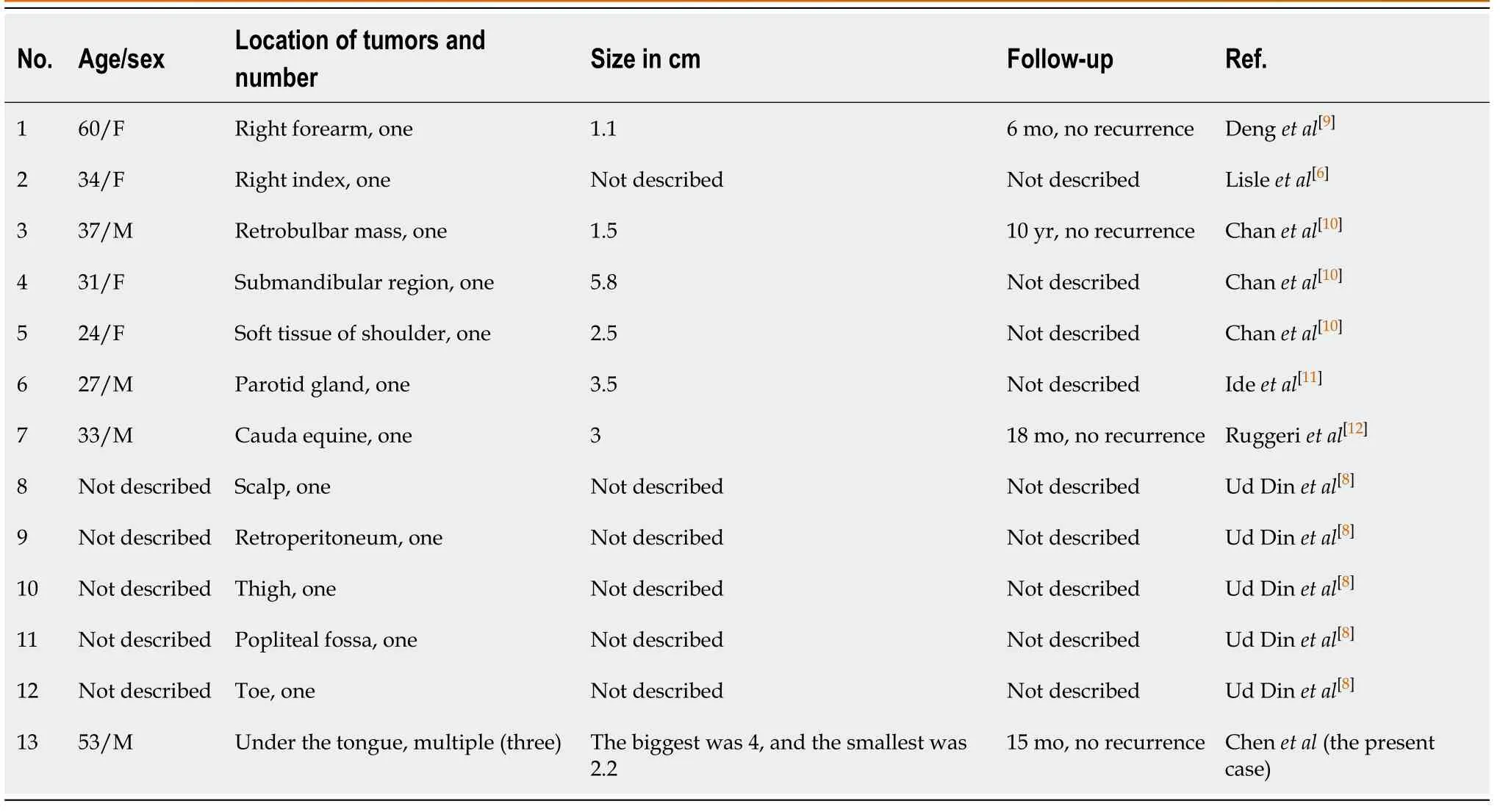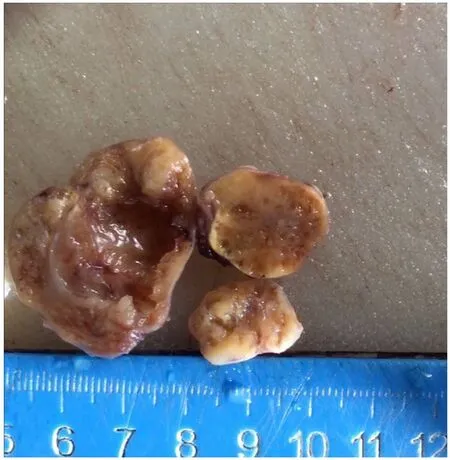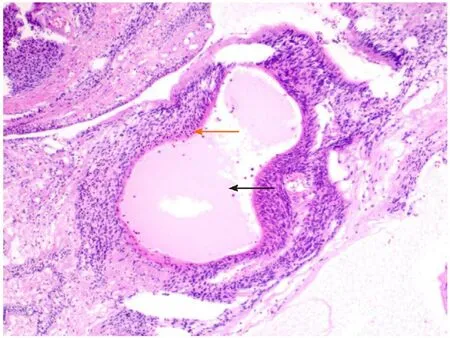Multiple schwannomas with pseudoglandular element synchronously occurring under the tongue:A case report
2020-04-08
Yong-Lin Chen,Department of Pathology,The First Hospital of Lanzhou University,Lanzhou 730000,Gansu Province,China
Deng-Qi He, Department of Oral Surgery,The First Hospital of Lanzhou University,Lanzhou 730000,Gansu Province,China
Hai-Xia Yang,Department of Pathology,Gansu General Hospital of Armed Police,Lanzhou 730030,Gansu Province,China
Yu Dou,Department of Radiology,The First Hospital of Lanzhou University,Lanzhou 730000,Gansu Province,China
Abstract BACKGROUND Schwannoma is a rare benign,encapsulated tumor of the nerve sheath under the tongue,mostly occurring as solitary tumors with classical histological pattern and several common morphological variants. To our knowledge,multiple schwannomas with pseudoglandular element synchronously occurring under the tongue are rare; we report herein the first such case.CASE SUMMARY A 53-year-old man had first noticed an isolated asymptomatic mass under the tongue,and as the mass grew,the tongue was elevated. Physical examination showed multiple oval neoplasms,and the overlying mucosa was normal.Computed tomography showed three low-density oval neoplasms under the tongue,which were cystic-solid with unclear boundary. The patient has no cutaneous tumors,VIII nerve tumors,or lens opacities and no history of neurofibromatosis 2 or confirmed schwannomatosis in any first-degree relative.Magnetic resonance imaging showed no evidence of vestibular schwannoma. The preoperative diagnosis was mucoepidermoid carcinoma. During hospitalization,all neoplasms were completely excised by surgeons through an intraoral approach under general anesthesia. The diagnosis of the multiple schwannomas with pseudoglandular element was made by histopathology after surgery. At the 15-mo follow-up visit,the patient had no sign of recurrence or development of other peripheral nerve tumors. CONCLUSION Although rare,multiple schwannomas with pseudoglandular element do exist in patients presenting with masses under the tongue. Oral surgeons should be aware of the existence of multiple schwannomas with pseudoglandular element when considering masses under the tongue due to the different prognosis between multiple schwannomas with pseudoglandular element and mucoepidermoid carcinoma.
Key Words: Case report; Multiple schwannomas; Pseudoglandular variant; Tongue;Mucoepidermoid carcinoma
INTRODUCTION
Schwannoma is a rare benign,encapsulated tumor of the nerve sheath under the tongue,and it mostly occurs as solitary tumors with classical histological pattern and several common morphological variants. Multiple schwannomas with pseudoglandular element synchronously occurring under the tongue are of great rarity. Here,we present the first report of a case of multiple schwannomas with pseudoglandular element synchronously occurring under the tongue.
CASE PRESENTATION
Chief complaints
A 53-year-old man had first noticed an isolated asymptomatic mass under the tongue,and then the mass grew,causing the tongue to be elevated.
History of present illness
The patient has no cutaneous tumors,VIII nerve tumors,or lens opacities.
History of past illness
The patient has no history of neurofibromatosis 2 or confirmed schwannomatosis in any first-degree relative.
Physical examination
Physical examination showed multiple oval neoplasms,and the overlying mucosa was normal. We considered mucoepidermoid carcinoma as our main differential diagnosis.
Laboratory examinations
All neoplasms were completely excised by surgeons through an intraoral approach under general anesthesia. There was no communication between the neoplasms and nerve bundles. Gross examinations showed three separated oval encapsulated masses with smooth surface. The biggest tumor was 4 cm × 3 cm × 3 cm,and the smallest was 2.2 cm × 1.8 cm × 1.3 cm. The sectioned surface was grayish-white in color and cysticsolid lesion with moderate hardness (Figure 1). Microscopic examination showed a lesion composed of bland spindle cells and demonstrated typical Antoni A and Antoni B areas with scattered pseudoglandular and microcystic foci. These pseudoglandular and microcystic areas were lined by flat to cuboidal cells (Figure 2). Some cystic areas showed hemorrhage. There were some hyalinized blood vessels elsewhere. No mitotic figure was found in tumor cells. The tumor cells and lining cells were positive for the S-100 protein and negative for Ckp protein by immunohistochemistry (IHC) staining(Figure 3).
Imaging examinations
Computed tomography showed three low-density oval neoplasms under the tongue,which were cystic-solid lesion and unclear boundary (Figure 4). Magnetic resonance imaging scan showed no evidence of vestibular schwannoma.
Timeline
The timeline of case reports is shown in Table 1.
FINAL DIAGNOSIS
Consequently,the diagnosis of the multiple schwannomas with pseudoglandular element under the tongue was established.
TREATMENT
During hospitalization,the all neoplasms were completely excised by surgeons through an intraoral approach under general anesthesia. Three days after the operation,the patient recovered well and discharged.
OUTCOME AND FOLLOW-UP
The diagnosis of the multiple schwannomas with pseudoglandular element was made by histopathology after surgery. At the 15-mo follow-up visit,the patient had no sign of recurrence or no other peripheral nerve tumors had developed.
DISCUSSION
Schwannomas are benign neoplasms derived from Schwann cells[1]. They mostly occur as solitary tumors[2]. Multiple schwannomas developing in individual nerves are very rare[3]. Ogoseet al[4]reported multiple schwannomas were in 4.6% of all patients with schwannoma. Their presence may be one of the symptoms indicative of neurofibromatosis 2,which is an autosomal dominant inherited disorder,or schwannomatosis,which is recognized as the third main form of NF[5].
Apart from the classic biphasic pattern,schwannomas may show several common morphologic variants including cellular,plexiform,epithelioid,ancient,and glandular variants[6]. A very rare pseudoglandular variant that has gland-like structure or cystic spaces that sometimes contain secretion-like material was first described by Ferry and Dickersin in 1988[7]. Since then,this extremely rare variant has been reported in a few case reports. The frequency of pseudoglandular element was 6.3% of schwannomas[8].Most cases of schwannomas with pseudoglandular element have shown a predilection for location in the spinal nerve roots. Ud Dinet al[8]and Robinsonet al[15]reported that 56 or 61 cases (91.8%) and 13 of 16 cases (81%),respectively,showed pseudoglandular spaces located in the spinal nerve roots. Other schwannomas with pseudoglandular elements have been described only in single case reports and involved the right forearm,the right index finger,the retrobulbar region,submandibular region,soft tissue of shoulder,the parotid gland,the scalp,the retroperitoneum,thigh,popliteal fossa,and toe (Table 2)[6,8-12]. However,to date,schwannomas with pseudoglandular element located under the tongue have not been described previously in the Englishliterature. In order to broaden further the clinicopathological spectrum of schwannomas with pseudoglandular element,we present the first report of a case of multiple schwannomas with pseudoglandular element under the tongue.

Table 1 Timeline of this case

Table 2 Summary of schwannoma with pseudoglandular elements located outside the central nervous system,including the presented case
The gland-like structure or cystic spaces in the pseudoglandular variant of schwannomas must be different from those true glandular structures in schwannomas and mucoepidermoid carcinoma[13]. These pseudoglandular structures are lined by Schwann cells,and these lining cells were positive for the S-100 protein and negative for Ckp protein by IHC staining[14]. Robisonet al[15]suggested that the pseudoglandular element schwannomas likely represented a type of response to degenerative changes,perhaps reflecting the propensity of the tumors to form palisading structures.However,the true glandular structures in schwannomas may line intestinal and respiratory type epithelium[16],representing true epithelial differentiation,and IHC stains are negative for S-100 and positive for epithelial membrane antigen and Ckp.The theory is that glandular schwannomas are derived from multipotential neural crest cells that can develop into various phenotypes. This would explain the different types of elements found in schwannomas. Another conjecture is that tumorigenesis may involve stem cells with the potential to produce both neural and heterologous elements[17].

Figure 1 Three separated oval encapsulated masses with smooth surface. The sectioned surface was grayish-white in color and cystic-solid lesion.

Figure 2 Pseudoglandular areas were lined by flat to cuboidal cells.
Mucoepidermoid carcinoma (MEC) is characterized by variable components of squamoid,mucin-producing,and intermediate-type cells,with a cystic and solid growth pattern[18]. However,it is usually difficult to distinguish MEC based on computed tomography. IHC stains are negative for S-100 and positive for epithelial membrane antigen and Ckp. MECs are characterized by gene translocation and fusion,but their diagnostic and clinical implications in the pathological evaluation remain uncertain.
CONCLUSION
We suggest that multiple schwannomas with pseudoglandular element may affect a wider range of body locations than previously reported. It is important to deepen our understanding of the clinicopathological spectrum of multiple schwannomas with pseudoglandular element so as to avoid its misdiagnosis.

Figure 3 Immunohistochemistry stains showed strong S-100 protein positivity in the cells lining pseudoglandular cystic spaces as well as intervening cells.

Figure 4 Computed tomography showed three low-density oval neoplasms under the tongue.
杂志排行
World Journal of Clinical Cases的其它文章
- COVID-19:A review of what radiologists need to know
- Holistic care model of time-sharing management for severe and critical COVID-19 patients
- Bioequivalence of two esomeprazole magnesium enteric-coated formulations in healthy Chinese subjects
- Osteoprotegerin,interleukin and hepatocyte growth factor for prediction of diabetes and hypertension in the third trimester of pregnancy
- High serum lactate dehydrogenase and dyspnea:Positive predictors of adverse outcome in critical COVID-19 patients in Yichang
- Risk factors analysis of prognosis of adult acute severe myocarditis
